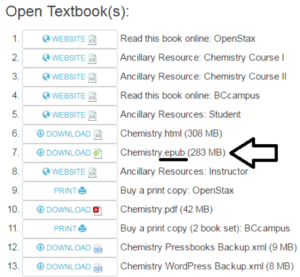12 Format Guide: OpenStax
In this guide, we introduce how to work with the OpenStax Connexions Legacy Editor. Many OpenStax textbooks are also available in Pressbooks and EPUB through the BCcampus Open Textbook Project (search for “OpenStax”). Please consult our Pressbooks and EPUB Format Guides for guidance on how to edit those formats.
Before we get started, a couple of notes:
- If your primary editing aim is to rearrange content, you may want to consider simply hyperlinking readings in the order you prefer, using your learning management system (LMS).
- If you’re hoping to reduce the textbook print price by reducing the number of pages, please keep in mind that custom printing an OpenStax book may ultimately result in higher overall costs, even when custom books have fewer pages. This is because small or custom print runs are usually more expensive than large-volume print runs. Customization may also limit resale value, which may be of concern to your students. If you decide to use a print-on-demand online vendor for a customized OpenStax textbook, the vendor should be able to project the cost in advance, based on number of pages, book dimensions, binding type, and color. OpenStax also has relationships with many custom printers if students want print copies of customized versions. Local solutions may also exist (your library or campus bookstore may have an Espresso Book Machine, for example).
OpenStax content is also available in iBook, HTML, and PDF. This guide does not cover editing OpenStax content in those three formats.
Original Format |
Possible Editing Tools (Web) |
Possible Editing Tools (Desktop) |
Possible Output |
| Connexions platform | Legacy | — | HTML on Connexions’ platform, CNXML, PDF, EPUB |
| Pressbooks (XML/WXR) | Pressbooks | — | Pressbooks HTML, PDF, EPUB, MOBI, ODT |
| EPUB | Pressbooks | Sigil, calibre |
Pressbooks: PDF, EPUB, HTML, .wxr Sigil: EPUB calibre: EPUB |
Editing in Legacy, the OpenStax Connexions Editor
OpenStax’s editing platform “Legacy” is freely available at http://legacy.cnx.org. Note that nearly all OpenStax content has a CC BY license (the three-volume Calculus texts, which have a CC BY-NC-SA license, are the exception). If you change or add images and text, ensure that they’re CC BY licensed or in the public domain and correctly attributed.
Here’s how to get started:
- Create account: CNX requires its own login account separate from openstax.org. You may use your same credentials for both, but must create an account in CNX in order to edit. There may be a brief waiting period before you can access your CNX account.
- Login: While viewing an OpenStax book you wish to edit, log in via the CNX Author | Legacy Site link in the upper right corner. That will bring you to the Collection (OpenStax term for book), where you can edit a Module (section or chapter).
- Editing interface: Making a derivative copy of an entire book may take a minute or two, so patience is needed. Once a copy is created, use the drag-and-drop interface at the chapter or section level. After making any changes, be sure to click the Publish tab to save. Your work is saved to your Personal Workspace (MyCNX), which can contain entire books or your own collection of various items. These files can be made accessible to others via a URL.
- Documentation: See Connexions Tutorials and Reference. This site provides extensive but concise help on CNXML, the language used in OpenStax.
- Multimedia content: See Adding Multimedia for information on how to provide accessibility, proper CNXML codes, etc.
Watch video: Creating Derived Copies on Connexions
Additional Help
OpenStax provides documentation and email help. For CNX technical support, contact: info@openstax.org or OpenStax Customer Support: 713-348-5012. OpenStax also offers up to 10 hours of technical assistance annually to schools with an institutional partnership.
Pressbooks & EPUB
Many OpenStax textbooks are available in Pressbooks and EPUB through the BCcampus Open Textbook Project. Search the BCcampus OpenEd site for “OpenStax” and see the Pressbooks and EPUB Format Guides for additional guidance.

Contributors: Kathy Labadorf, Anita Walz
Special thanks: Nicole Finkbeiner and Brittany Weinstein (OpenStax), Lauri Aesoph (BCCampus)

